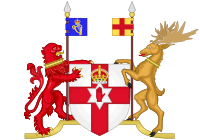Prime Minister of Northern Ireland facts for kids
Quick facts for kids Prime Minister of Northern Ireland |
|
|---|---|

Arms of the Executive Committee
|
|
| Nominator | House of Commons |
| Appointer | Governor of Northern Ireland |
| Term length | At His Majesty's pleasure
so long as General Elections are held no more than five years apart.
|
| Inaugural holder | Sir James Craig |
| Formation | 7 June 1921 |
| Final holder | Brian Faulkner |
| Abolished | 30 March 1972 (suspended) 18 July 1973 (abolished) suspended in 1972 and then abolished in 1973, along with the contemporary government, when direct rule of Northern Ireland was transferred to London. |
| Succession |
|
The Prime Minister of Northern Ireland was the main leader of the Northern Ireland government from 1921 to 1972. This important job was not officially created by the law that set up Northern Ireland's government in 1920. However, the top official, known as the Lord Lieutenant of Ireland, decided to appoint someone to lead the government, much like in other countries that follow the "Westminster system" (like Canada).
The person chosen for this role took the title Prime Minister to show it was similar to the prime minister of the United Kingdom. Later, a special "Department of the Prime Minister" was created to support this role. The job of Prime Minister of Northern Ireland was stopped in 1972. It was then officially removed in 1973. This happened when control of Northern Ireland was moved directly to London, a process called direct rule.
Contents
How the Prime Minister Was Chosen
The law from 1920 allowed the Governor to pick people for the government's main committee. There was no need for a vote in parliament to choose the Prime Minister. In theory, the Prime Minister and the committee didn't have to answer to the House of Commons of Northern Ireland.
However, in practice, the Governor always chose the leader of the political party that had the most seats in the House. This was always the leader of the Ulster Unionist Party. This party was very strong in elections, winning many times. All the Prime Ministers of Northern Ireland were also members of the Orange Order, a Protestant organization.
Where Prime Ministers Lived
From 1920 to 1922, the Prime Minister lived at a place called Cabin Hill. This building later became a junior school. After 1922, Stormont Castle was used as the Prime Minister's official home. However, some Prime Ministers chose to live in Stormont House. This was a large house meant for the Speaker of the House of Commons of Northern Ireland, but it was not used by the Speaker.
What Came After the Prime Minister Role
The role of Prime Minister of Northern Ireland ended in 1972/1973. Later, in 1998, new leadership roles were created by the Good Friday Agreement. These new roles are the first minister and deputy first minister. Unlike the old system, which was like the UK's "Westminster style," the new Northern Ireland Executive works differently. It uses a system called consociational democracy. This means different groups share power.
In 1974, Brian Faulkner led the Northern Ireland Executive. But he was called the Chief Executive of Northern Ireland, not the Prime Minister.
List of Northern Ireland Prime Ministers
| No. | Name (Born–Died) Area Represented |
Portrait | Time in Office | Elected (Parliament) |
Government | Party | Last Job Before Becoming Prime Minister | ||
|---|---|---|---|---|---|---|---|---|---|
| 1. | Sir James Craig (became The 1st Viscount Craigavon in 1927) (1871–1940) MP for Down until 1929 MP for North Down from 1929 |
 |
7 June 1921 | 24 November 1940 | 1921 (1st) | Craigavon | Ulster Unionist Party | Parliamentary and Financial Secretary to the Admiralty (1920–1921) |
|
| 1925 (2nd) | |||||||||
| 1929 (3rd) | |||||||||
| 1933 (4th) | |||||||||
| 1938 (5th) | |||||||||
| 2. | John Miller Andrews (1871–1956) MP for Mid Down |
 |
27 November 1940 | 1 May 1943 | — (5th) | Andrews | Ulster Unionist Party | Minister of Finance (1937–1941) | |
| 3. | Sir Basil Brooke (became The 1st Viscount Brookeborough in 1952) (1888–1973) MP for Lisnaskea |
 |
1 May 1943 | 26 March 1963 | — (5th) | Brookeborough | Ulster Unionist Party | Minister of Commerce (1941–1943) |
|
| 1945 (6th) | |||||||||
| 1949 (7th) | |||||||||
| 1953 (8th) | |||||||||
| 1958 (9th) | |||||||||
| 1962 (10th) | |||||||||
| 4. | Terence O'Neill (1914–1990) MP for Bannside |
 |
25 March 1963 | 1 May 1969 | — (10th) | O'Neill | Ulster Unionist Party | Minister of Finance (1956–1963) | |
| 1965 (11th) | |||||||||
| 1969 (12th) | |||||||||
| 5. | James Chichester-Clark (1923–2002) MP for South Londonderry |
 |
1 May 1969 | 23 March 1971 | — (12th) | Chichester-Clark | Ulster Unionist Party | Minister of Agriculture (1967–1969) Leader of the House of Commons (1968–1969) |
|
| 6. | Brian Faulkner (1921–1977) MP for East Down |
23 March 1971 | 30 March 1972 | — (12th) | Faulkner | Ulster Unionist Party | Minister of Development (1969–1971) | ||

